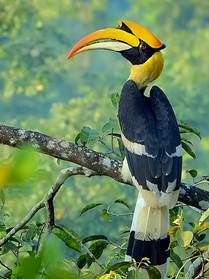Ecological Context
- Species: Buceros bicornis (Great Hornbill), locally known as Malamuzhakki Vezhambal.
- Conservation Status:
- IUCN: Endangered
- Indian Wildlife Protection Act, 1972: Schedule I species (maximum protection)
- Typical Habitat: Evergreen and moist deciduous forests of the Western Ghats.
- Notable ranges: Silent Valley, Parambikulam, Athirappilly, Nelliyampathy, Aralam.

Relevance : GS 3(Environment and ecology)
The Sighting: Key Facts
- Location: Kakkampara near Ezhimala, Kannur, Kerala – a coastal belt.
- Date: First spotted on May 24, 2025.
- Duration of Stay: The bird remained in the area for about two weeks.
- Initial Sighting: Perched on a fig-laden Ficus exasperata tree.
- Movement: Foraged in the area, flew occasionally to nearby habitats including the Ezhimala Naval Academy campus.
- Observers: Birdwatchers Manoj Karingamathil, P. Jameela, and forestry student Abhinav Jeevan.
Significance of the Sighting
- Geographical Rarity:
- Great Hornbill sightings in coastal zones are highly unusual; primarily forest dwellers.
- No documented evidence exists of previous sightings this close to the sea in Kannur district.
- Ecological Indicator:
- Presence outside its traditionalrange may indicate:
- Shifting habitat preferences due to climate change or forest degradation.
- An underexplored biodiversity hotspot in the Ezhimala-Ramanthali belt.
- Presence outside its traditionalrange may indicate:
- Biodiversity Significance:
- Local governance (Ramanthali Grama Panchayat) hailed the sighting as proof of continued biodiversity richness despite human habitation.
- Reinforces importance of semi-urban fringe areas as ecological buffers.
Conservation & Policy Implications
| Indicator | Details |
| Conservation Priority | High (Endangered, Schedule I species) |
| Conservation Concern | Habitat shrinkage, forest fragmentation, poaching |
| Policy Call | Need for micro-level habitat protection in coastal areas |
| Research Need | Mapping of non-traditional sightings and coastal foraging corridors |
| Citizen Science Role | Accidental discovery via WhatsApp status, highlighting scope of public involvement in biodiversity tracking |
Broader Ecological Reflections
- Climate Link?: Possible range shifts due to habitat loss, climate stressors, or changing food availability.
- Seed Disperser Role: Hornbills play a crucial role in forest regeneration through dispersal of fig and fruit tree seeds.
- Conservation Gap: Coastal ecosystems often overlooked in hornbill conservation plans, despite potential seasonal or adaptive significance.
Way Forward
- Biodiversity Zonation: Integrate coastal hills like Ezhimala into eco-sensitive zone mapping.
- Species Monitoring: Use citizen science + academic research to build sighting databases.
- Community Engagement: Train local communities to identify and report rare wildlife sightings.
- Habitat Linkage: Restore coastal-forest ecological corridors for seasonal/occasional wildlife dispersal.



